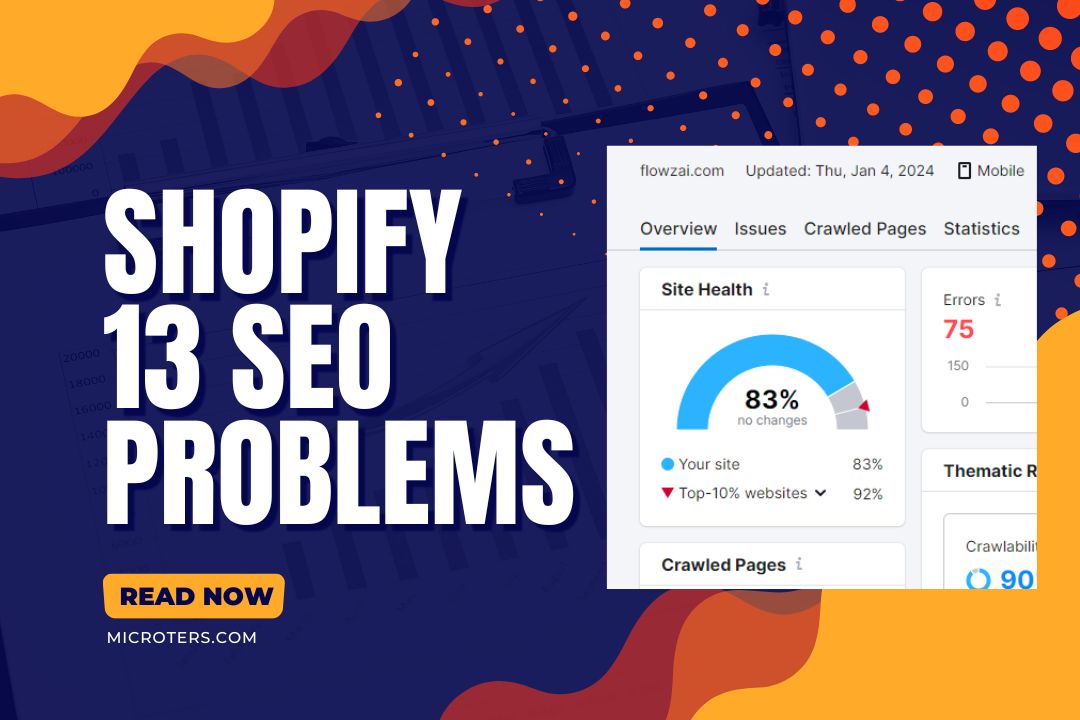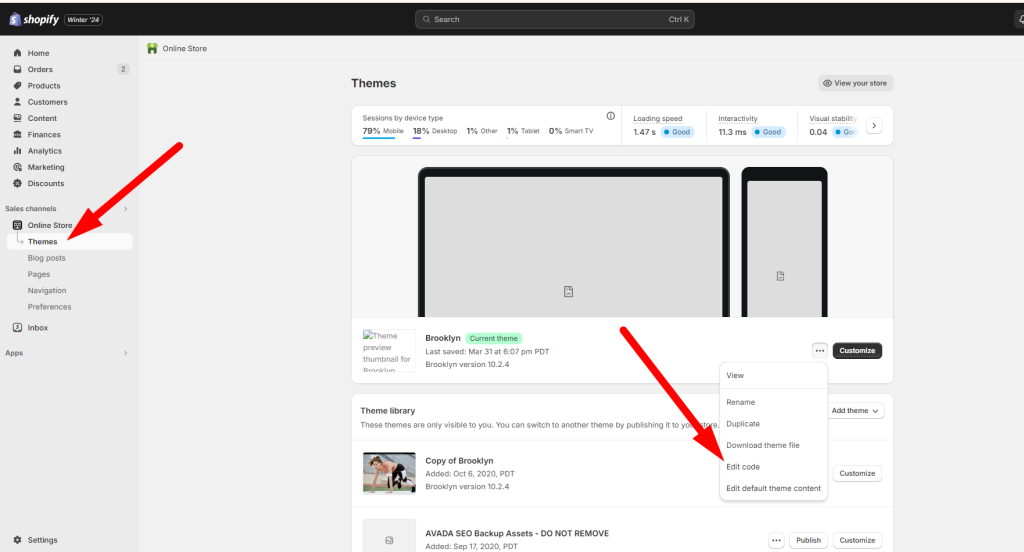Table of Contents

If you run a Shopify store, you know how important having a strong online presence is. Yet, even with the winning products and content, you could still end up having zero visitors at your online store if it lacks optimization for search engines.
That's where Shopify SEO becomes a concern. From sluggish page loads to subpar title tags or poor URL structures to limited redirects, many things can hamper your store's visibility and impact sales.
So, here, we address 13 such Shopify SEO problems and how you can overcome them. If implemented right, these fixes can enhance your store's visibility, drive more traffic, and boost sales.
13 Common Shopify SEO Problems and Solutions
SEO, be it Shopify stores or anything on the web, is all about showing up high on Google, Bing, and similar search engines. But that feat can be hard to achieve if your online shop isn’t set up right.
Check out these 13 common SEO problems many startup owners face while setting up their Shopify store and how to fix them.
1. Slow Page Load Speed
Let’s begin with arguably the most critical aspect of user experience and SEO. When your page takes longer to load, it increases the bounce rate, as potential customers may lose patience and click away.
This, in turn, can harm your rankings since search engine algorithms take bounce rates into account. So, to improve your page load speed, here are a few things you should try:

2. Lack of Unique and Compelling Product Descriptions
To draw in customers and amp up your store's visibility on search engines, creating distinctive and captivating product descriptions is vital. These not only offer key details about your products but also set your store apart from the competition.
Here are some strategies to create unique and compelling product descriptions:
3. Poorly Optimized Title Tags and Meta Descriptions
Tweaking your title tags and meta descriptions is ever plays a big role in boosting your Shopify store’s presence on the SERP. No matter how small, they share key info about your product page with both users and search engines.
That’s why you should always look to craft concise and descriptive title tags, incorporating primary keywords. Try to stick to around 60 characters to ensure visibility in search results. Also, steering clear of duplicate tags across pages is vital for avoiding confusing search engines and hurting your SEO.
Likewise, you should keep meta descriptions as brief as under 160 characters. But they should be summarizing your page's content with relevant keywords. And you must skip duplicate descriptions and include a call to action to prompt users to click through.
4. Inadequate Keyword Research
Your Shopify store's SEO performance is hard to improve without conducting effective keyword research. But when done right, it can unveil what your audience is searching for and guide you to the key terms that matter.
You can try these steps for proper keyword research for your products:
For example, if you're into handmade jewelry, your key terms could be "handmade jewelry," "artisan jewelry," or "unique jewelry."
If you aim for long-tail keywords related to your business you can bring in focused traffic and boost conversions.
5. Duplicate Content Problems
Having the same content in multiple places can badly hurt your Shopify store's SEO. It not only damages your page rankings but also confuses search engines. Hence, to boost your store's visibility and authority, finding and fixing these issues is crucial.
One common type of duplicate content is when you have the same product page linked from different URLs. This might occur if your products are in multiple collections or if you offer different versions of the same product.
Here are three common scenarios that you may encounter and how you can tackle them.
| Problem | Solution |
| Duplicate product pages | Use canonical tags to specify the preferred URL for the product page. This tells search engines which page to display in search results. |
| Duplicate content within your website | Review your website content and eliminate any repetitive or duplicate information. |
| Duplicate content from external sources | Use plagiarism detection tools to identify and remove any copied content. |
6. Pagination Problem
Even when your store has no duplicate content, Shopify's way of organizing pages can create the problem of having the same content on different pages.
Moreover, they don't support tags like rel=”next” and rel=”prev,” which tell search engines about the connection between pages in a series. It's worth noting that Google moved on from these tags a while back, though some other search engines might still use them.
The thing is, pagination can make search engines see the same products on multiple pages, confusing and potentially lowering your rankings in search results.
To tackle this issue, you can take up these strategies.
To tackle pagination problems, you've got a few options:
Create fallback URLs for each content section and link them with rel=“next” and rel=“prev” to help search engines crawl and index your content smoothly.
7. Poor URL Structure
Oftentimes, search engines struggle to understand your page content if you don’t organize the URLs properly, which can impact your rankings massively.
How to Create SEO-Friendly URLs for Your Shopify Store
To improve your store's URL structure, you can follow this simple checklist:
For example, if you sell shoes on your Shopify store, an SEO-friendly URL for a product page could look like this:
| Poor URL Structure | SEO-Friendly URL |
| https://www.example.com/product/12345 | https://www.example.com/shoes/nike-air-max-90 |
As you can see, the poor URL structure uses a generic product ID number, which barely tells search engines or users anything about the item being sold. The SEO-friendly URL, on the other hand, contains descriptive keywords that clearly hint at what the page is about.
8. Limited Redirects
Shopify only does permanent redirects with 301s—those send your customers from one URL to another permanently. It doesn't do the temporary redirects, like 302s or 307s. This can make it a bit tricky when you want to shuffle things around on your online store.
Most SEOs love using 301 redirects. They're like the go-to move. But there are times when you might want to do a quick, temporary switch. Without that option for temporary redirects, it could be a bit tough to fine-tune your store from a techy SEO perspective.
Shopify doesn't do temporary redirects by default, but you can make it happen with an app like Easy Redirects (they've got a free plan). This app lets you set up both 301 and 302 redirects and handle your site's redirects as you want.
9. Canonical URLs
The HTML link element includes a crucial part known as the canonical URL. This URL helps Google and other search engines explore and organize the page effectively. If there's an issue with the canonical URL, Google might receive duplicate content, leading to potential harm to SEO.
For example, these product URLs are quite similar, making it challenging for Google to identify the most relevant one:
Dealing with canonical URL problems means handling pages that can be reached through different web addresses. While Shopify offers a redirect tool, it may not work well if the targeted site is already in existence. Plus, for those not well-versed in SEO, finding the most effective approach for desired results can be challenging.
But the good news is, fixing this issue is pretty straightforward. Just tweak your Shopify theme file a bit, and you're good to go. Here's a quick guide:
Step 1: Go to Online Store => Shopify Themes on your left sidebar.
Step 2: Click the Actions button => Edit the code.

Step 3: Look for "product-grid-item.liquid" in "Snippets" and click on it.

Step 4: Make this change
<a href=”{{ product.url | within: current collection }}” class=”product-grid-item”>
Step 5: Change it to this code
<a href=”{{ product.url }}” class=”product-grid-item”>With this code adjustment, all your links to product pages will use the correct URL path.
10. Inefficient Internal Linking
Are you interlinking between the pages of your Shopify store? When used effectively, internal links can help distribute link authority, enhance user navigation, and, thus, improve the overall SEO performance.
So, if you've yet to create SEO-friendly internal links, here’s how to get started:
But more importantly, interlinking this way helps search engines understand your Shopify store's content structure.
11. Not Using Enough Alt Texts for Images
Alt text, or "alternative text," contributes heavily to image SEO. It helps search engines understand what an image is about, which may lead to your store being more visible on search engines.
Including alt texts is particularly important because:
How to Add Alt Text to Your Images
Adding alt text to your images on Shopify is as easy as following these four steps:
When writing alt texts, remember to -
Optimizing Your Images for SEO
While adding alt text is essential, optimizing your images for SEO goes beyond just adding descriptions. Check out these additional tips for optimizing your Shopify images:
12. Lack of Rich Snippets and Schema Markup
Is your Shopify store lacking in rich snippets and schema markup? That's another reason that could be costing your site search engine traffic and visibility.
Many believe they’re only used for better looks. In reality, though, when you use these tools, your store not only looks better in search results but also gives users helpful information.
So, first, let's talk about what rich snippets and schema markup are before we go into how you’ll implement them.
What are Rich Snippets?
Rich snippets are special data that give search engines extra details about your store's content. This info can cover things like product ratings, reviews, prices, and availability. Rich snippets can boost how many people click on your site and bring in more focused visitors by showing more details in search results.
What is Schema Markup?
Schema markup is like a special code that helps search engines get what your store's pages are all about. When you put schema markup on your pages, you're giving search engines extra details about your store's products, services, and content.
How Do You Implement Rich Snippets and Schema Markup?
Shopify supports rich snippets and schema markups either through apps or through theme modifications. Here are some steps you could follow:
13. Ignoring Mobile Optimization
Did you know that over 57% of online traffic comes from mobile devices?
This means if your Shopify store isn't tailored for mobile, it hurts your Shopify store’s SEO ranking. And let’s not forget the substantial pool of potential customers you’re overlooking.
So, here are a few tips for creating a mobile-friendly and responsive Shopify store for both SEO and sales boost.
Conclusion
And there you have it, a comprehensive guide on some of the key factors leading to common Shopify SEO problems. Remember, implementing these strategies isn't a one-time event but an ongoing process.
So, continue testing and refining your approach utilizing tools like Google Analytics to monitor your website's performance and customer behavior insights. And don’t shy away from seeking help from SEO experts or using supportive resources that Shopify offers.




Leave a Reply